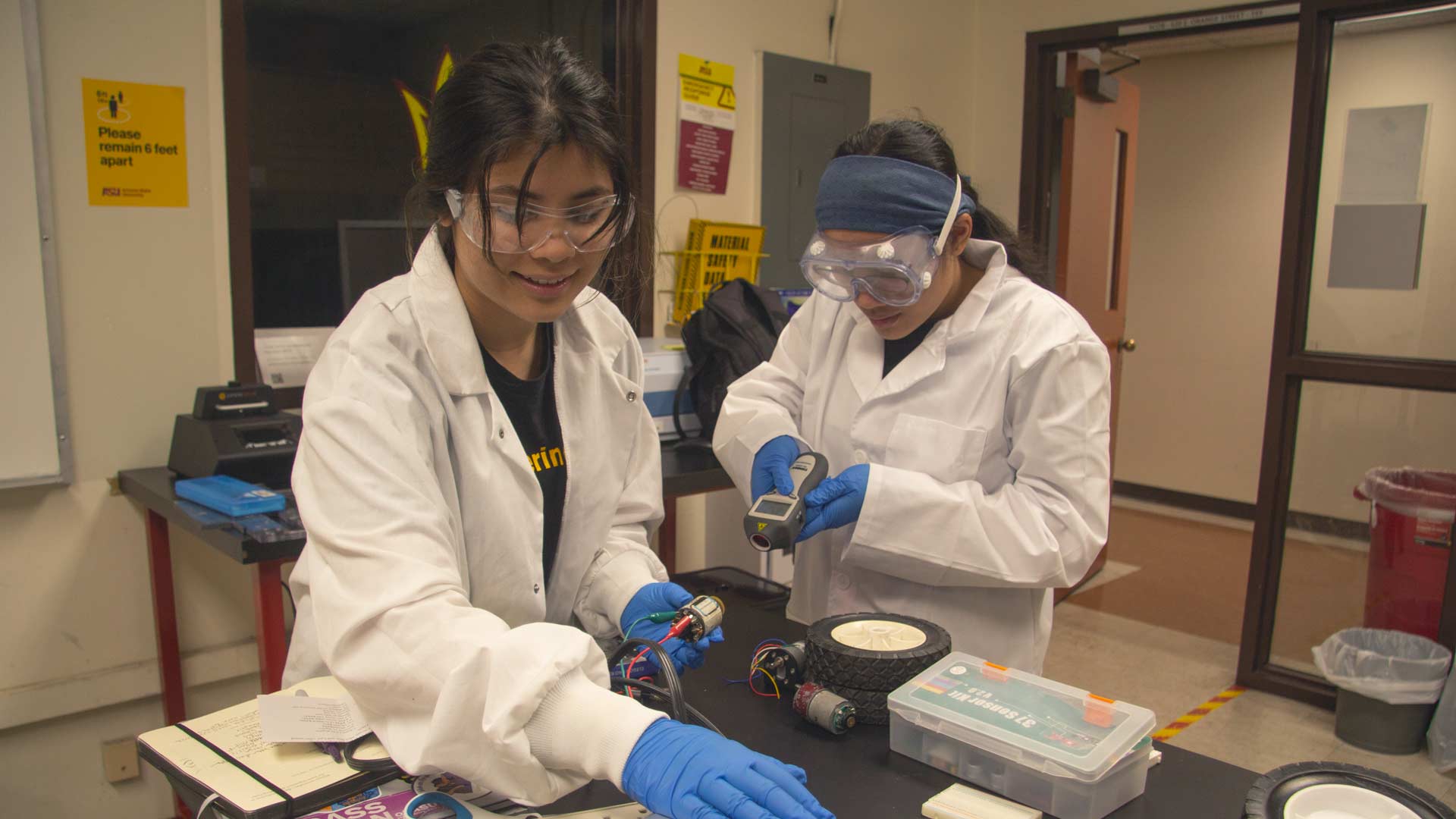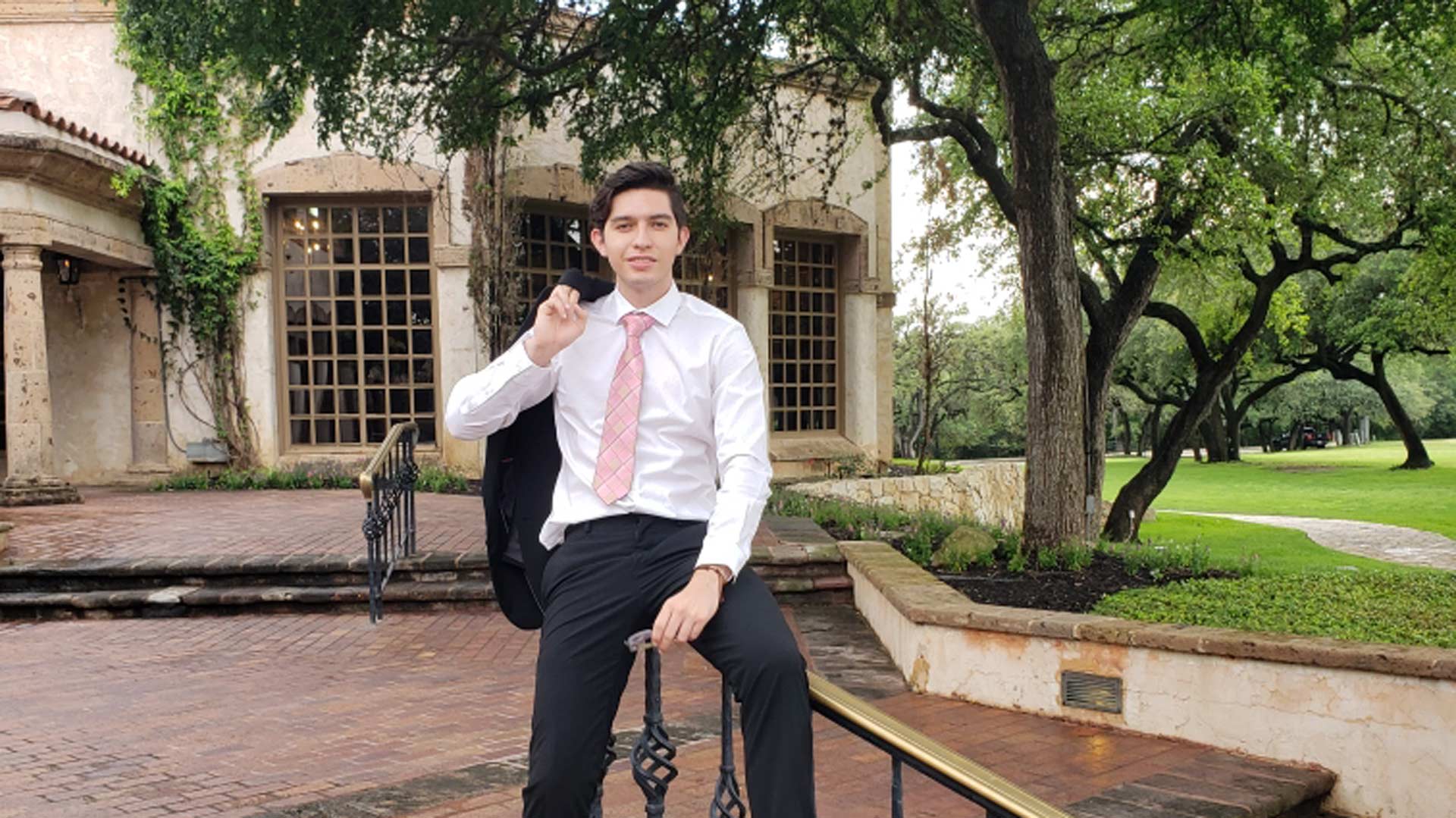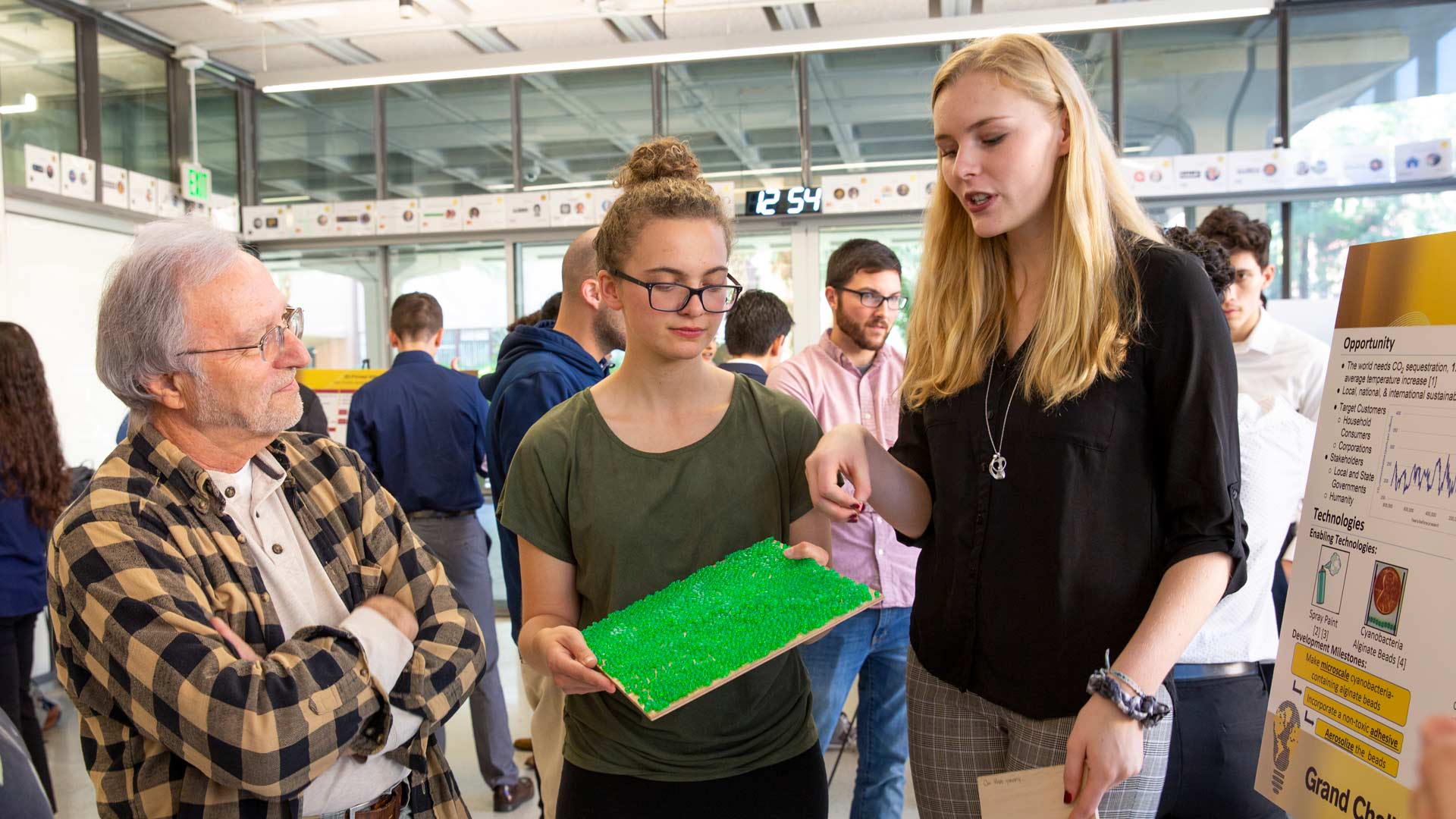Grand Challenges Scholars graduate from ASU with prospects for bright future

Students in Arizona State University’s Grand Challenges Scholars Program prepare to address global concerns through competencies that impart an ability to see the big picture, consider all aspects of a problem and create value for society. Photo by Thia Fuller/ASU
The Grand Challenges Scholars Program is a unique experience for engineering and technology students at Arizona State University that encourages them to diversify their academic journey beyond engineering by exploring studies in culture, ethics, policy, human behavior, entrepreneurship and other related disciplines. In addition to earning engineering degrees, the program enables students to graduate with majors or minors in multiple areas of study or enhance their degrees with extracurricular research and service learning.
Known as GCSP, the program is offered by the Ira A. Fulton Schools of Engineering at ASU and gives students opportunities to address global concerns.
“Our spring 2023 graduates have accomplished a lot, and have left an impact on the ASU and Fulton Schools community,” said Amy Trowbridge, director of the GCSP program and an associate teaching professor in the Fulton Schools.
“But their impact doesn’t stop there; they’ve also had a positive impact on local and global communities, either through their leadership as Fulton Ambassadors, or through various projects they completed in Engineering Projects in Community Service (EPICS), or Engineers Without Borders.”
Trowbridge said many GCSP students spent their time in the program deeply engaged in research, spending multiple semesters working with faculty mentors to analyze and develop solutions to help people and society. More than half, she adds, also graduated from Barrett, The Honors College.
This spring, 17 Grand Challenges Scholars graduated through the program.
“Although the COVID-19 pandemic may have thwarted some of their plans to study abroad or implement international service projects, these students were still motivated to put their skills to use to benefit society any way that they could,” Trowbridge said.
“Nearly all of (this year’s GCSP graduating class) participated in EPICS, working on projects to improve medical care, sustainable farming, access to clean water or other important goals for communities in Africa, Vietnam, Kenya, Peru and here in Arizona,” she said. “Several of them used their leadership skills to inspire others to pursue engineering and give back to society as Fulton Ambassadors, through leadership in student (organizations) and outreach activities.”
To graduate as a Grand Challenges Scholar, students must exhibit five competencies through research or a creative project, a multidisciplinary learning experience, entrepreneurship, a multicultural experience or a service-learning project. We spotlight four of the Scholars and their projects below.
Utilizing science for a sustainable future

Grand Challenges Scholar Salma Ly (left) said considering sustainability as a mindset and in practice is something she is constantly aware of as a researcher and as a person. Photo by Hayley Hilborn/ASU
Salma Ly, who graduated with a Bachelor of Science in chemical engineering, said she encourages students to adopt the mindset of becoming a leader in all aspects of life.
“To become a well-rounded leader is to excel not only in accomplishing things yourself but inspiring those around you to make that change as well, and providing the opportunity for them to do so,” Ly said.
Ly liked the concept of the GCSP program and said the challenges not only provided useful directions as she participated in competitions and research opportunities, but gave her perspectives on how to view her internship experiences.
When Ly started out in GCSP as a first-year student, she was most interested in the latest fusion reactor technology but has since gravitated toward carbon dioxide capture and processing design.
For the past three years, Ly worked in Associate Professor Matthew Green’s research group, focusing her efforts on carbon capture using polymers to directly capture CO2 from the air.
This year, the San Antonio, Texas, native was captain of ASU’s ChemE Car, overseeing the technical team that qualified and competed in national and regional competitions.
“We developed a chemical-reaction-run car using sustainable power sources like thermoelectric generators,” Ly said. “This expanded my horizons on sustainability in power and the safety concerns and data conversion involved in transitions from thermal to electrical to mechanical power.”
Sustainability was always at the forefront as Ly made the decisions that led her into the chemical engineering field.
“I love the forest, plants and the beautiful Earth we live on,” Ly said. “I know where we are headed, and if it takes us away from sustainable practices, it will be a dark place. It will be like the signs of poor health you see in people who must work in nonregulated, unsafe environments. Knowing on a molecular level what we can do about it and being able to scale up a process to take advantage of sustainable practices is my ultimate goal.”
After graduation, Ly plans to work in process optimization for Boeing and will also pursue a master’s degree.
Engineering global health and well-being

Grand Challenges Scholar Sumi Ramachandran looks to improve access to health care and incorporate her strengths by providing personalized care for patients. Photo courtesy Sumi Ramachandran
Sumi Ramachandran, who graduated with a Bachelor of Science in chemical engineering, joined the program the first semester of her junior year because it offered an abundance of opportunities to enrich her university experience and career prospects.
“Through GCSP, I have been able to focus on my goals of creating sustainable health-care practices through a health theme that focuses on improving the physical well-being and life span of humans while reducing the negative ecological impacts on our society,” Ramachandran said.
One of the multiple projects the Gilbert, Arizona, native worked on in her time at ASU was with the Engineering Projects in Community Service program.
Ramachandran joined a team working on smart agriculture, in which she and her peers designed a working model of a rainwater pH monitoring system for eventual implementation in Danang, Vietnam, to increase the efficiency and sustainability for small-scale farmers. Work on the project involved visiting Vietnam.
“Providing reliable access to smart agriculture technologies may not only be good for people’s health, safety and lifestyle, but also have positive economic and societal impacts as well,” Ramachandran said
“During my 10 days there, our team spent time visiting the farmers, touring the area and understanding the problems that they face. We were able to perfect our design from this input and with the help of students and faculty members from the University of Danang,” she said. “The experience emphasized the importance — especially when discussing health in a community — of the interconnectedness of many outside factors such as the economy, culture and demographics.”
After completing the Grand Challenges Scholars Program, Ramachandran realized how it has shaped her into who she is today.
“I am a confident and well-rounded engineer prepared to tackle society’s biggest challenges,” Ramachandran said. “I do not simply recommend engineering students join the program; I strongly advocate for it. It is a great starting point to make the most out of our time at Arizona State University.”
Creating efficient technology for a sustainable future

Grand Challenges Scholar Daniel Espinoza Peña plans to continue learning about leading-edge robotic technology and apply it to projects that relate to sustainability. Photo courtesy Daniel Espinoza Peña
Daniel Espinoza Peña, who graduated with a Bachelor of Science in engineering focusing on electrical systems and a minor in technological entrepreneurship management, got involved with GCSP soon after he was accepted into the program.
“At that point in time I was open to every opportunity offered to me and took it with the understanding that the program would guide me to become an outstanding engineer,” Espinoza Peña said. “Four years later and I am graduating fulfilled and satisfied, and a primary contributor to that achievement is being involved in GCSP.”
Espinoza Peña did not know at first what he wanted to do in the GCSP program, only that he wanted to have a positive impact on the world, no matter how small or grand.
“I decided to go forward with the grand challenge theme of sustainability to help preserve our world while also improving people’s lives,” Espinoza Peña said. “I pondered two outcomes for the future, which are that we develop technology to either make life sustainable on Earth by improving the climate or focus our efforts on building a civilization off-world.”
Among Espinoza Peña’s projects was leading the Sun Devil Motorsports Formula Electric team and the 2021 Solar District Cup team, which designed a mock business with a team leveraging autonomous electric vehicle technology and reducing manufacturing costs for an industry partner by redesigning an environmental control unit.
“All of these projects follow concepts of reducing waste and creating efficient systems,” the Goodyear, Arizona, native said. “This might be through renewable energy, efficient management structures, cost reduction, etc. I believe as engineers we are always pushing the boundaries of functionality before hitting that failure threshold all in the name of reducing the waste a product or system creates.”
For Espinoza Peña, the field of autonomous mobile robotics is of particular interest because of how robotics is capable of being applied to numerous engineering endeavors.
“There are more and more robots being developed each and every day, and the technology will keep advancing in the consumer, industrial and space exploration fields,” Espinoza Peña said. “The almost infinite number of applications is what draws me into this area. I want to use robotics as a means to improve people’s lives.”
He will continue learning about the robotics field, with plans to begin graduate studies next spring in the Fulton Schools accelerated master’s degree program in robotics and autonomous systems with a focus on systems engineering.
Removing carbon to preserve the climate

Grand Challenges Scholar Emily Hagood (right) plans to start her career in the carbon management industry in San Francisco. Photo by Erika Gronek/ASU
Emily Hagood, who graduated with a Bachelor of Science in materials science and engineering with a minor in sustainability, has been interested in sustainability since third grade, when she started a recycling program at her elementary school.
During her first semester at ASU, Hagood took FSE 150: Perspectives on Grand Challenges for Engineering, an introductory GCSP course, that required her to interview an ASU faculty member about their research.
“I interviewed Klaus Lackner, who pioneered research on direct air carbon capture technologies, and fell in love with direct air capture and other carbon removal and storage technologies,” Hagood said. “One of the National Academy of Engineering Grand Challenges is to develop carbon sequestration methods, and I’ve been working on that Grand Challenge since my interview with Dr. Lackner.”
That interview completely changed the course of Hagood’s academic and professional career aspirations.
“It’s all because of GCSP that I discovered and later pursued opportunities in the field of carbon management,” she said.
Hagood’s research primarily focused on the physical durability, or permanence, of various kinds of reservoirs for stored carbon dioxide. She quantitatively explored how long carbon tends to remain sequestered in certain reservoirs — whether the nature of the reservoir is biotic (such as trees or wetlands), oceanic (such as a water column or other storage reservoirs in the ocean), geologic (such as depleted oil and gas reservoirs) or otherwise engineered (such as converting captured CO2 into plastics or fuels).
Climate change is one of the most urgent, far-reaching and complex challenges the world is facing, and it’s one the Birmingham, Alabama, native wants to take on.
“Direct air capture and carbon removal are areas of both personal and professional interest because I want to be part of the climate solution,” Hagood said.
Following graduation, she will begin her professional career at Heirloom, a direct air capture company based in San Francisco.
A grand future
These graduates have left a mark on the ASU and global communities as they seek to make the world a better place.
Through completion of the five components of the GCSP program, the students had the opportunity to engage in research, explore interdisciplinary coursework, gain an international perspective, engage in entrepreneurship and give back to the community through service-learning projects.
They will be recognized by the National Academy of Engineering as Grand Challenges Scholars, joining a community of more than 2,000 total GCSP alumni across the organization’s international network and including 124 at ASU.
“These students embraced interdisciplinary experiences and valued the global interdisciplinary perspective, one of the key features distinguishing Grand Challenges Scholars from other engineering graduates,” Trowbridge said. “Through their experiences, they learned the importance of working on multidisciplinary teams and understanding the sociocultural, ethical and political context of a problem when developing an effective engineering solution.”
“They encouraged others to look at the bigger picture, too,” Trowbridge said. “Each of these students followed their passions to develop an individualized pathway to success as a Grand Challenges Scholar, impacting many people along the way. I look forward to watching how each of them continues to create value for their communities and our global society as a whole in the future.”
More Science and technology

ASU professor breeds new tomato variety, the 'Desert Dew'
In an era defined by climate volatility and resource scarcity, researchers are developing crops that can survive — and thrive —…

Science meets play: ASU researcher makes developmental science hands-on for families
On a Friday morning at the Edna Vihel Arts Center in Tempe, toddlers dip paint brushes into bright colors, decorating paper…

ASU water polo player defends the goal — and our data
Marie Rudasics is the last line of defense.Six players advance across the pool with a single objective in mind: making sure that…

